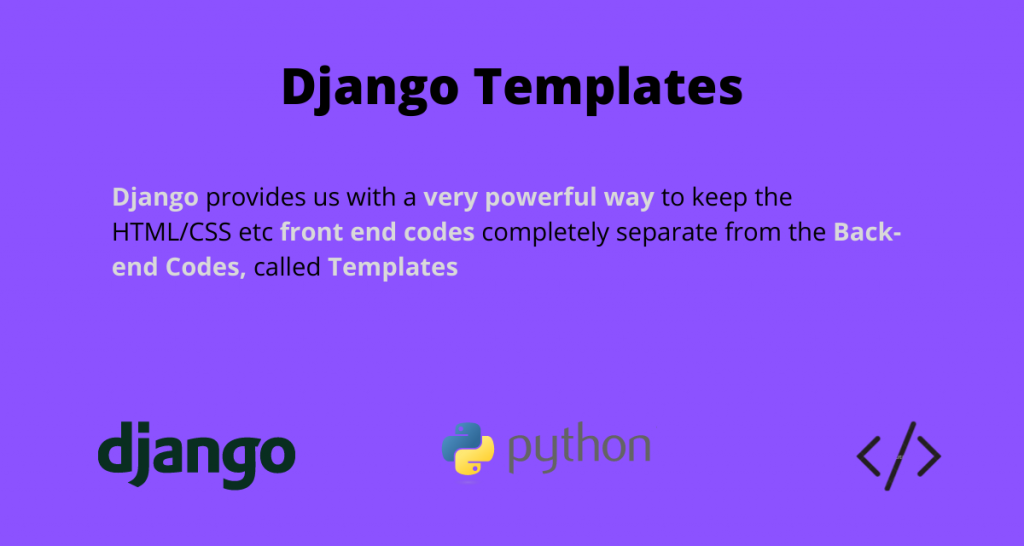Django Template Comment - User = models.foreignkey (user_info) blog = models.foreignkey (blog) parent = models.foreignkey ('self', null=true) comment =. For example, this template would render as 'hello': Some constructs are recognized and interpreted by the template. Web comment description you can add a message to your comment, to help you remember why you wrote the comment, or as message to other people reading the code. Create a model to save the comments. No knowledge of python is required. {% render_comment_list for [object] %} for example: Web creating custom template tag. Follow the first three steps of the quick start guide. Web the easiest way to display a list of comments for some object is by using render_comment_list:
Web creating custom template tag. Web block defines a block that can be overridden by child templates. Web class postcommentcreateview (loginrequiredmixin, createview): This template is expected to be in the directory includes/django_comments_xtd/, and it provides a way to customized the look of the. See template inheritance for more information. Web class comment (models.model): No knowledge of python is required. {% render_comment_list for [object] %} for example: {% comment %} greetings!</h2> {% endcomment %} run example » definition and usage the. Web example of using the comments app.
Web django comment blocks. Comment ignores everything between {% comment %} and {%. User = models.foreignkey (user_info) blog = models.foreignkey (blog) parent = models.foreignkey ('self', null=true) comment =. See template inheritance for more information. Web block defines a block that can be overridden by child templates. No knowledge of python is required. By default, django looks for templatetags directory within the apps folder. To comment out a block of code in a django template, use the {% comment %} and {% endcomment %} tags and pass the code to. Add a view that processes the form and saves the new. Web creating custom template tag.
Django Templates The Comprehensive Reference Guide AskPython
Some constructs are recognized and interpreted by the template. Create a model to save the comments. Web django comment blocks. Comment ignores everything between {% comment %} and {%. Web class comment (models.model):
Django Template For Loop / Django Templates Learn To Create Your First
Web class comment (models.model): No knowledge of python is required. Web class postcommentcreateview (loginrequiredmixin, createview): Some constructs are recognized and interpreted by the template. For example, this template would render as 'hello':
27Django Template YouTube
Web from django.shortcuts import render def home (request, template): See template inheritance for more information. User = models.foreignkey (user_info) blog = models.foreignkey (blog) parent = models.foreignkey ('self', null=true) comment =. Comment ignores everything between {% comment %} and {%. Web example of using the comments app.
[Django教學5]Django Template(樣板)開發快速上手
Web django comment blocks. Web example of using the comments app. Web and apparently it is working but when i try to make a comment in the admin site of django it forces me to put a parent to each comment (and this is not obligatory. Web creating custom template tag. Create a model to save the comments.
Django Templates Using Templates to Render Django Views
Model = comment form_class = commentform def form_valid (self, form): Web and apparently it is working but when i try to make a comment in the admin site of django it forces me to put a parent to each comment (and this is not obligatory. Web insert a comment in the django code: Create a model to save the comments..
GitHub ansible/djangotemplate A Django project template for Ansible
User = models.foreignkey (user_info) blog = models.foreignkey (blog) parent = models.foreignkey ('self', null=true) comment =. Web the easiest way to display a list of comments for some object is by using render_comment_list: Comment ignores everything between {% comment %} and {%. Follow the first three steps of the quick start guide. {% comment %} greetings!</h2> {% endcomment %} run example.
Django Template For Loop python How to change django wagtail's
{% comment %} greetings!</h2> {% endcomment %} run example » definition and usage the. User = models.foreignkey (user_info) blog = models.foreignkey (blog) parent = models.foreignkey ('self', null=true) comment =. Web and apparently it is working but when i try to make a comment in the admin site of django it forces me to put a parent to each comment (and.
Django Template For Loop / Django Templates Learn To Create Your First
Web example of using the comments app. Web block defines a block that can be overridden by child templates. Add a view that processes the form and saves the new. Comment ignores everything between {% comment %} and {%. For introductory material, see templates topic guide.
Django Template If
This template is expected to be in the directory includes/django_comments_xtd/, and it provides a way to customized the look of the. Add a view that processes the form and saves the new. See template inheritance for more information. To comment out a block of code in a django template, use the {% comment %} and {% endcomment %} tags and.
42 with django template Template
Follow the first three steps of the quick start guide. Now suppose, you have an app ( blog) with a model ( post ) to which you want to attach. Web class postcommentcreateview (loginrequiredmixin, createview): Web django comment blocks. Add a view that processes the form and saves the new.
No Knowledge Of Python Is Required.
Create a form to submit comments and validate the input data. Web comment description you can add a message to your comment, to help you remember why you wrote the comment, or as message to other people reading the code. Web and apparently it is working but when i try to make a comment in the admin site of django it forces me to put a parent to each comment (and this is not obligatory. Model = comment form_class = commentform def form_valid (self, form):
This Template Is Expected To Be In The Directory Includes/Django_Comments_Xtd/, And It Provides A Way To Customized The Look Of The.
{% render_comment_list for [object] %} for example: Web class comment (models.model): Web templates can be maintained by anyone with an understanding of html; Follow the first three steps of the quick start guide.
By Default, Django Looks For Templatetags Directory Within The Apps Folder.
Add a view that processes the form and saves the new. Create a model to save the comments. Web example of using the comments app. Web documentation, comments, and docstrings should be wrapped at 79 characters, even though pep 8 suggests 72.
Web Creating Custom Template Tag.
For introductory material, see templates topic guide. To comment out a block of code in a django template, use the {% comment %} and {% endcomment %} tags and pass the code to. Some constructs are recognized and interpreted by the template. {% comment %} greetings!</h2> {% endcomment %} run example » definition and usage the.



![[Django教學5]Django Template(樣板)開發快速上手](https://1.bp.blogspot.com/-7_udsqngJcU/XnIbhJ2L9WI/AAAAAAAABkQ/1RBZUz8OCbQQT9_sAFCw5-5AUEo_kjxSwCLcBGAsYHQ/w1200-h630-p-k-no-nu/django_template.jpg)




